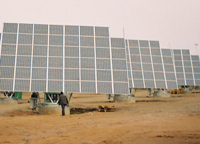Feb 12 2008
The Basque ALBIASA group has development plans to invest 300 million euros up to 2010 aimed at promoting various photoelectric parks, a thermosolar plant and premises for the manufacture of photoelectric cells.

The thermosolar plant is to be located in Saucedilla (Cáceres), three kilometres from the Almaraz nuclear plant, and will have a capacity for the generation of 50 MW and occupy a surface area of 270 hectares, the technology used being cylindrical-parabolic collectors. The prototypes have been designed by ALBIASA SOLAR, being an advance over collectors currently available on the market for this novel energy sector, given that costs savings are incorporated – reducing the material and number of pieces used and enabling a more effective and simpler assembly.
These prototypes are found at the Almeria Solar Platform in test phase and ALBIASA SOLAR, apart from using them in the thermosolar plant being projected for Saucedilla, will maintain the patent for its marketing to third parties.
The plant will use networks that will be used to evacuate the energy generated by the nuclear installation belonging to the utility Iberdrola. At the thermosolar plant, with an investment of 200 million euros, ALBIASA SOLAR will develop all the engineering work and maintain 10% of capital interest. The other 90% will be in the hands of an international fund that invests in renewable energies.
The innovative aspect of this plant is its using to the full the maximum radiation in a location with the microclimate of the north of Cáceres, taking advantage of the sinuous terrain and water resources in the region, being completely neutral with the environment (with pastures and wetlands, and so on), in such a way that integration with the natural landscape is total. The thermosolar installation will be built practically within a solar energy theme park.
The plan will begin construction in the first term of 2008. It will be made up of a cylindrical-parabolic concentrator (CCP), which owes its name to one of its main components: the cylindrical-parabolic reflective surface that reflects the solar radiation directly concentrating it on an absorbent tube placed at the focal line of the parabola.
This radiation concentrated on the absorbent tube makes the fluid circulating inside heat up, thus transforming solar radiation into heat energy – in the form of sensitive or latent heat of the fluid. As with any other concentrator, it can take advantage of direct solar radiation, thus requiring the collector to modify its position through the day. This movement is achieved by means of rotation around an axis parallel to its focal line.
Solar gardens
The ALBIASA SOLAR company is currently promoting the installation of three photoelectric plants or “solar gardens” in the province of Cáceres - with an overall capacity of 7 MW.
The company currently has its solar plant at Villanueva de la Reina, in Jaén, in operation, with 2 MW of power. This solar plant is one of the first to incorporate two axes solar tracking technology with production in Andalusia and is notable for the total of its installed power – the second largest in the Andalusian Community.
Also, in February 2008 the plants at Socuéllamos (Ciudad Real) (2.8 MW) will be connected to the grid. In August of this year the fields at Casatejada (Cáceres) (7 MW) will be connected.
The 13,580MWh of estimated overall annual production from solar gardens are equivalent to the electric consumption of 4,381 homes, avoiding the emission into the atmosphere of about 13,281 tons of CO2.